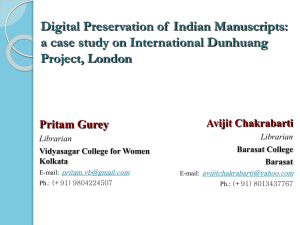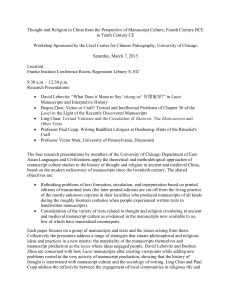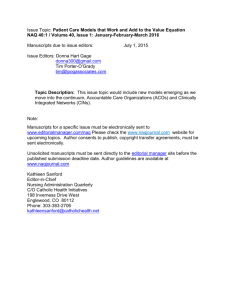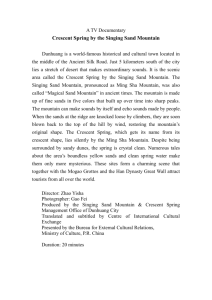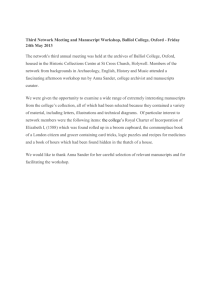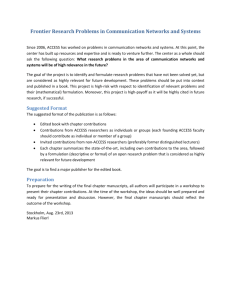Priorities for Research on Dunhuang Manuscripts
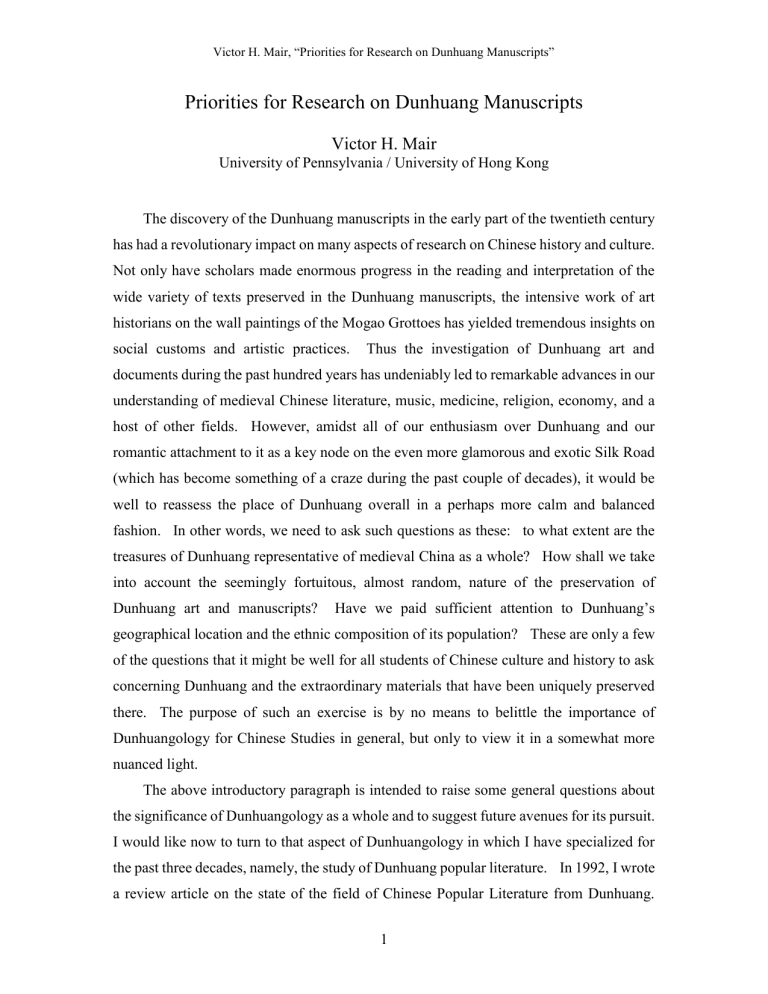
Victor H. Mair, “Priorities for Research on Dunhuang Manuscripts”
Priorities for Research on Dunhuang Manuscripts
Victor H. Mair
University of Pennsylvania / University of Hong Kong
The discovery of the Dunhuang manuscripts in the early part of the twentieth century has had a revolutionary impact on many aspects of research on Chinese history and culture.
Not only have scholars made enormous progress in the reading and interpretation of the wide variety of texts preserved in the Dunhuang manuscripts, the intensive work of art historians on the wall paintings of the Mogao Grottoes has yielded tremendous insights on social customs and artistic practices. Thus the investigation of Dunhuang art and documents during the past hundred years has undeniably led to remarkable advances in our understanding of medieval Chinese literature, music, medicine, religion, economy, and a host of other fields. However, amidst all of our enthusiasm over Dunhuang and our romantic attachment to it as a key node on the even more glamorous and exotic Silk Road
(which has become something of a craze during the past couple of decades), it would be well to reassess the place of Dunhuang overall in a perhaps more calm and balanced fashion. In other words, we need to ask such questions as these: to what extent are the treasures of Dunhuang representative of medieval China as a whole? How shall we take into account the seemingly fortuitous, almost random, nature of the preservation of
Dunhuang art and manuscripts? Have we paid sufficient attention to Dunhuang’s geographical location and the ethnic composition of its population? These are only a few of the questions that it might be well for all students of Chinese culture and history to ask concerning Dunhuang and the extraordinary materials that have been uniquely preserved there. The purpose of such an exercise is by no means to belittle the importance of
Dunhuangology for Chinese Studies in general, but only to view it in a somewhat more nuanced light.
The above introductory paragraph is intended to raise some general questions about the significance of Dunhuangology as a whole and to suggest future avenues for its pursuit.
I would like now to turn to that aspect of Dunhuangology in which I have specialized for the past three decades, namely, the study of Dunhuang popular literature. In 1992, I wrote a review article on the state of the field of Chinese Popular Literature from Dunhuang.
1
Victor H. Mair, “Priorities for Research on Dunhuang Manuscripts”
Although I focused on the decade of the eighties, which witnessed an explosive burst of scholarly activity in this field, I also took advantage of that opportunity to look back at the previous seventy and more years of research on popular literature from Dunhuang.
Among the more obvious desiderata that I mentioned in that review article was the urgent need for scholars to produce an adequate catalog of all the Dunhuang manuscripts preserved in China. The situation has not changed since I wrote my review article in 1992.
Still today, nearly half a century after Lionel Giles completed his admirable (considering that it was done by one man) descriptive catalog of the Dunhuang manuscripts in the
British Museum (now in the British Library), and decades after the French brought out four of the five thick volumes of their excellent catalog of the Dunhuang manuscripts in the
Bibliothèque Nationale ( Catalogue des manuscrits chinois de Touen-houang ), all that we have for the thousands of Dunhuang manuscripts in China is the pathetically inadequate
Dunhuang yishu zongmu suoyin (hereafter DYZS ), which was first compiled and published
(obviously in great haste) by the Commercial Press in 1962, and then reissued by
Zhonghua in 1983 without corrections, amplifications, or additions. It is supremely ironic that the Dunhuang manuscripts in London and in Paris are far better described in DYZS than are those preserved in the Beijing National Library, the Library of Peking University, and other collections in China. In my estimation, the compilation of a decent catalog of the Dunhuang manuscripts in China is a matter of the greatest scholarly urgency, far more important than trying to figure out the exact dates of the beginning of the Xia (?), Shang, and Zhou dynasties. China mobilized an army of researchers to work on the San Dai project and wasted millions of dollars. And it was all for nought. The money and the scholarly energy would have been far better spent on compiling a good catalog of the
Dunhuang documents.
It is all the more ironic that China lacks a respectable catalog of its Dunhuang documents in light of the tremendous number of Dunhuang specialists in that country and the large number of books published each year that have to do with Dunhuang. Surely there are a sufficient number of qualified specialists in China to compile an excellent catalog of Dunhuang manuscripts, yet – mysteriously – no one has taken it upon him/herself to initiate this most needed reference tool. Instead, we have a continual series
2
Victor H. Mair, “Priorities for Research on Dunhuang Manuscripts” of collation notes being issued in an attempt to arrive at definitive readings of texts that, in essence, are impossible to normalize.
From 1957 when it was first published, the “standard” edition of Dunhuang popular literature was Dunhuang bianwen ji . Although it was certainly not without its faults, this collection of texts edited by Wang Zhongmin and colleagues was serviceable, more or less in the same way that the Taisho Tripitaka is for the Chinese Buddhist canon
.
1 Dunhuang bianwen ji functioned as a widely available repository of printed texts to which researchers could conveniently refer when doing their more specialized types of research. In 1994,
Pan Chonggui published his deceptively entitled Dunhuang bianwen ji xin shu , which was really not very “new” ( xin ). That is to say, it basically just copied Dunhuang bianwen ji , adding only a few collation notes, many of which were mere quibbles, and quite a few of which were off the mark. To this day, I find it difficult to comprehend why Pan Chonggui would have invested so much time in producing a work of so little utility. Be that as it may, Pan’s Xinshu opened the floodgates to a new round of attempts to arrive at a definitive edition of Dunhuang popular narratives.
2
In 1997, Huang Zheng and Zhang Yongquan published Dunhuang bianwen jiaozhu .
In this large volume, Huang and Zhang relied on the massive amount of close reading of the texts that had been carried out by numerous scholars during the eighties and early nineties and added many judicious observations of their own. Thus there is no doubt that
Dunhuang bianwen jiaozhu is superior in many respects to Dunhuang bianwen ji . Yet, I do not think that Dunhuang bianwen jiaozhu will replace Dunhuang bianwen ji both because the latter is too deeply entrenched in the scholarly literature and also because the former does not constitute a quantum leap forward as did the Dunhuang bianwen ji over its predecessors.
Next came Dunhuang bianwen jiangjingwen yinyuan jijiao compiled by Zhou
Shaoliang, Zhang Yongquan, Huang Zheng.
3
This work in two volumes is relatively expensive, occurs in a notable series, and has a presumptuous appearance. It must be admitted that its compilation notes are extensive, yet they are far from exhaustive. The fact that Dunhuang bianwen jiangjingwen yinyuan jijiao , like many other editions of
Dunhuang popular texts (but not [N.B.] Dunhuang bianwen ji ), is written by hand rather
3
Victor H. Mair, “Priorities for Research on Dunhuang Manuscripts” than being typeset, belies a common fetish in Dunhuang manuscript studies, to which I now turn.
A vast amount of energy has been expended on trying to determine exactly which standard characters were intended by the Dunhuang scribes when they wrote their scrolls and booklets. Scholars argue constantly and endlessly over the “correct” readings of particular characters. What I would like to propose here is that, when we are dealing with a manuscript tradition like that of the Dunhuang texts, there may well be no single, correct reading. Often, the characters that Dunhuang scribes used are sui generis . We may make an intelligent guess at their meaning, but sometimes it is impossible to confidently equate a given Dunhuang graph with a standard graph from one of the traditional lexicons, even the very largest ones. To cite only three examples from a single short text (S2464) that I have been working on for the last few weeks, the title of the first text on the manuscript has the graph *A*. It is fairly certain that the scribe intended by this the word bi4 (“wall”) that is usually written *B*. But are we justified in normalizing *A* as *B*? Perhaps. In the text itself, we come across two extremely rare graphs, *C* and *D*. From the context, I surmise that the first may mean something like “strife” and the second might possibly mean “hunger.” It is even conceivable that the first graph is an unusual variant of *E*
( dou4 ), but I have no clear idea whether the second graph is a variant of some other character. In other words, I would be extremely reluctant to substitute other characters for either *C* or *D*.
4
The same type of ambiguity is true of other manuscript traditions in China (e.g., writing on the Chu bamboo strips and silk manuscripts, the bronze inscriptions, and the oracle bone inscriptions).
5 Imre Galambos, a paleographer employed by the International
Dunhuang Project of the British Library, has emphasized the extraordinary range of differentiation in Han seal script and in late Warring States scripts. The First Emperor of the Qin Dynasty may have made heroic efforts to unify the various contending scripts into a single, national writing system, but he was fighting a losing battle. Even today, script reformers and language officials in China continually bemoan the lack of standardization in the Sinitic writing system, quite apart from the enormous separation into the two major subsystems of jianti (“simplified”) and fanti (“complicated,” i.e., “traditional”).
4
Victor H. Mair, “Priorities for Research on Dunhuang Manuscripts”
What does all this boil down to? What does it portend for the future of Chinese
Studies? Actually, rather than leaving me despondent, I actually feel that we have reached a stage where current technologies will enable future generations of scholars to abandon the endless squabbling over the almost unlimited range of graphical variants and concentrate on more significant issues (such as the meaning and interpretation of texts, the evolution of genres, sources, allusions, linguistic analysis, and so forth). Through the magic of the web-based International Dunhuang Project, it is already becoming a reality for Dunhuang scholars to view manuscripts preserved in institutions scattered around the world, while seated comfortably in front of their own computer terminal. What is more, it will eventually be possible to search for and compare specific graphic forms throughout the entire corpus. And all of this without causing any damage to the delicate scrolls by repeated handling on the part of countless eager researchers.
I believe that we are on the verge of tremendous breakthroughs in Dunhuang
Studies, and that the primary driving force in these breakthroughs will be web-based technologies. Incidentally, these exciting developments are true not just of texts, but also of the Dunhuang wall-paintings where, thanks to the generosity of the Carnegie-Mellon
Foundation, we can now visit three-dimensional reproductions of the caves on our computer screens that are superior (in terms of what we can actually see) than going personally to the caves ourselves.
So all is not bleak. Far from it! I should also mention that there is still plenty of room for more conventional types of scholarly activity relating to the Dunhuang manuscripts and that we already have much to be grateful for, including the very fine work that has been done on vows and prayers ( yuanwen ), folk rhapsodies ( fu ), verse (especially sung verse and the forerunners of lyric meters [ ci ] such as quzici ), social and economic history, and so forth.
6
In closing, I would venture to say merely that, in the century since it came into existence, Dunhuang Studies has accomplished an enormous amount and has had a decidedly positive influence on the course of nearly all aspects of Sinology relating to the medieval period and later. So long as its practitioners do not succumb to the temptation to keep recycling things that have already been done or to argue over trivial problems that cannot be solved, and so long as attention is paid to fundamental issues and energies are
5
Victor H. Mair, “Priorities for Research on Dunhuang Manuscripts” directed toward essential tools, the useful discoveries that await us in Dunhuang Studies will continue to benefit Chinese Studies as a whole.
1. It should be noted that Dunhuang bianwen ji had been preceded by a few earlier efforts to present Dunhuang popular narratives in typeset, published form (e.g., the publications by Zheng Zhenduo and by Zhou Shaoliang), but the work of Wang Zhongmin and his colleagues was so far superior to its predecessors that there is no wonder it completely replaced them.
2. I do not count Xiang Chu’s Dunhuang bianwen xuanzhu in this group of works, because
Xiang selected a limited number of texts and, above all, contributed numerous illuminating and insightful notes that are valuable aids to reading the texts.
3. Note that all three of the compilers of this work had been involved in earlier editorial efforts dedicated to Dunhuang popular narratives.
4. There have been several efforts to bring order to the unruly mass of Dunhuang graphical variants (e.g., Pan Chonggui’s Dunhuang suzi pu and Zhang Yongquan’s Dunhuang suzi yanjiu ). However, such works – large-scale though they are – were carried out mechanically before the availability of electronic data processing. Although they are helpful in reading Dunhuang manuscripts, they lack the comprehensiveness and immediate access that can only be afforded by huge databases.
5. This graphical ambiguity is true particularly of the oracle bone script, only about one third of whose three or four thousand symbols can be correlated with modern characters with any degree of confidence.
6. To prevent this short position paper from growing out of control, I omit here references to particular works, which are readily available in the very useful Dunhuangxue da cidian and in various bibliographies of Dunhuang Studies.
6
Victor H. Mair, “Priorities for Research on Dunhuang Manuscripts”
Works Cited
British Museum, Department of Oriental Printed Books and Manuscripts. Descriptive catalogue of the Chinese manuscripts from Tunhuang in the British Museum . By Lionel
Giles. London : Trustees of the British Museum, 1957.
Huang Zheng, Zhang Yongquan. Dunhuang bianwen jiaozhu [Collations and
Annotations of Dunhuang Transformation Texts] . Beijing: Zhonghua shuju, 1997.
Ji Xianlian, chief ed. Dunhuangxue da cidian [Large Dictionary of Dunhuangology] .
Shanghai: Shanghai cishu chubanshe, 1998.
Mair, Victor H. “Chinese Popular Literature from Tun-huang: The State of the Field
(1980-1990)." In Alfredo Cadonna, ed., Turfan and Tun-huang, the Texts: Encounter of
Civilizations on the Silk Route, Orientalia Venetiana, IV. Florence: Leo S. Olschki,
1992). Pp. 171-240.
Pan Chonggui. Dunhuang bianwen ji xinshu [New Edition of Collection of Dunhuang
Transformation Texts] . Taipei: Wenjin, 1994.
__________, et al . Dunhuang suzi pu [Tables of Colloquial Characters from Dunhuang] .
Taipei: Shimen tushu gongsi, 1978.
Shangwu yinshuguan, ed. Dunhuang yishu zongmu suoyin [Comprehensive Catalog of
Dunhuang Manuscripts] . Beijing: Shangwu yinshuguan, 1962; Zhonghua shuju, 1983.
Wang Zhongmin, chief ed. Dunhuang bianwen ji [Collection of Dunhuang
Transformation Texts] . 2 vols. Beijing: Renmin wenxue chubanshe, 1957.
7
Victor H. Mair, “Priorities for Research on Dunhuang Manuscripts”
Xiang Chu. Dunhuang bianwen xuanzhu [Selected and Annotated Dunhuang
Transformation Texts] . Chengdu: Bashu shushe, 1990.
Zhang Yongquan. Dunhuang suzi yanjiu daolun [An Introduction to the Study of
Dunhuang Colloquial Characters] . Taipei: Xinwenfeng chuban gongsi, 1996.
__________. Dunhuang suzi yanjiu [Studies on Dunhuang Colloquial Characters] .
Shanghai: Shanghai jiaoyu chubanshe, 1996.
Zhou Shaoliang, Zhang Yongquan, Huang Zheng, ed. Dunhuang bianwen jiangjingwen yinyuan jijiao (Collected Collations of the Transformation Texts, Sutra Lecture Texts, and
Nidanas from Dunhuang) . 2 vols. Dunhuang wenxian fenlei lujiao congkan [Collated
Texts of Dunhuang Documents in Various Categories]. Nanjing: Jiangsu Guji
Chubanshe, 1998.
8
